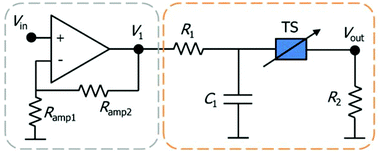Relaxation oscillator-realized artificial electronic neurons, their responses, and noise†
Abstract
A proof-of-concept relaxation oscillator-based leaky integrate-and-fire (ROLIF) neuron circuit is realized by using an amorphous chalcogenide-based threshold switch and non-ideal operational amplifier (op-amp). The proposed ROLIF neuron offers biologically plausible features such as analog-type encoding, signal amplification, unidirectional synaptic transmission, and Poisson noise. The synaptic transmission between pre- and postsynaptic neurons is achieved through a passive synapse (simple resistor). The synaptic resistor coupled to the non-ideal op-amp realizes excitatory postsynaptic potential (EPSP) evolution that evokes postsynaptic neuron spiking. In an attempt to generalize our proposed model, we theoretically examine ROLIF neuron circuits adopting different non-ideal op-amps having different gains and slew rates. The simulation results indicate the importance of gain in postsynaptic neuron spiking, irrespective of the slew rate (as long as the rate exceeds a particular value), providing the basis for the ROLIF neuron circuit design. Eventually, the behavior of a postsynaptic neuron in connection to multiple presynaptic neurons via synapses is highlighted in terms of EPSP evolution amid simultaneously incident asynchronous presynaptic spikes, which in fact reveals an important role of the random noise in spatial integration.



 Please wait while we load your content...
Please wait while we load your content...